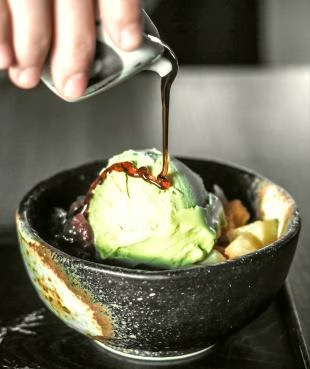Green tea and matcha are commonly used in desserts and drinks, and the two flavors are somewhat similar. But what’s the difference between green tea and matcha? How can you tell the difference between green tea and matcha? What is matcha? At the end of this article, we also recommend dessert combinations for both teas: matcha recipes and green tea recipes.
Green tea: High-temperature roasting followed by rolling creates flavor.
Distinguishing green tea from matcha based on color and flavor is often difficult. This is because matcha is actually a type of green tea.
Green tea is harvested from tea trees grown in the sun. The leaves are roasted at high temperatures to kill the buds and inhibit fermentation. They are then rolled to help develop the flavor, and then dried.
As a result, green tea leaves appear wrinkled and dry. They need to be brewed with hot water to relax and release the tea essence. Green tea powder is typically made by mechanically grinding the leaves after drying.
What is matcha?
Shaded from sunlight before harvest, steaming and grinding involve more steps.
Matcha is a type of green tea.
Matcha is mostly powdered. Matcha is made by shielding the green tea trees from sunlight from about 20 days to a month before harvest, allowing them to continue growing.
Matcha Production Process
After harvesting, the tea leaves are steamed and then dried with warm air. Coarse tea stems are removed, leaving intact leaves. The leaves are then ground into a powder using a low-temperature stone mortar. Matcha powder is bright green with a slight yellowish hue.
The grinding speed, temperature, and fineness also affect the quality of matcha powder. Matcha leaves must be picked from the first harvest of each year. For a strong matcha, the leaves should be sweet and not bitter. This also reflects the quality of good matcha powder. Besides careful selection of tea leaves, the tea flavor is sweet and less astringent.
High-quality matcha is said to have a light seaweed aroma.
Matcha is a type of green tea, but due to different cultivation and processing methods than green tea, the production process involves more steps and the flavor profile is also different.
Green Tea and Matcha: A Comparison of Their Characteristics
| Green Tea | Matcha | |
| Appearance | Dried tea leaves | Often in powdered form |
| Cultivation | Sunlight | Shaded from sunlight before harvesting |
| Production | Stir-fried and rolled at high temperatures, then dried. | Steamed, air-dried, and ground. |
| Characteristics | Stir-fried and rolled. | Grinded in a stone mortar. |
| Flavor | Sweet and astringent, varying depending on the variety. | High-quality tea has a seaweed aroma and is slightly sweet and less bitter. |
Green tea actually contains fewer nutrients than matcha.
Nutrientally, most tea leaves contain catechins, theanine, vitamins A, C, E, potassium, and calcium.
Because matcha is ground from whole tea leaves and the production process is performed at a lower temperature than green tea, it retains more nutrients. For example, matcha contains more tea polyphenols and vitamin C than green tea.
However, since the leaves are not consumed after brewing green tea, the actual nutrients consumed are lower than in matcha.
How to identify genuine matcha?
As for the quality of matcha, it is generally not easy to quickly determine. Some foods and desserts have mixed green tea powder with matcha, but since matcha is also a type of green tea, there are currently no strict regulations on its use.
Two identification tips: For example, unadulterated matcha should appear slightly thinner than thick after brewing. Also, if the color is too bright green, it may have been enhanced with coloring. Pay special attention when tasting matcha desserts and drinks.
Recommended Ways to Enjoy Green Tea and Matcha (recipe)
Green Tea with Fruit
Green tea and matcha are excellent for desserts, so here are a few tea-based desserts. After brewing green tea, you can create flavored drinks or jelly. Fruity flavors like passion fruit, apple, lemon, and orange are great, especially when squeezed and blended with juice or diced fruit to create a unique tea flavor.
If you have green tea powder or tea leaves on hand, add them to pancake batter or dough to imbue your pastries with a subtle tea aroma.
Matcha with Milk
As for matcha, try making the ever-popular matcha milk sauce. It’s perfect as a spread on toast or as a dip for cookies. Controlling the heat is crucial, so don’t rush.
For dessert beginners, try the easier-to-make matcha milk and steamed cakes. Compared to more challenging desserts, these have a lower barrier to entry. For example, “gradient matcha milk” is incredibly popular in cafes and hand-shake shops. Once you learn how to make it, you can create beautiful, photogenic matcha drinks at home.


Leave a Reply